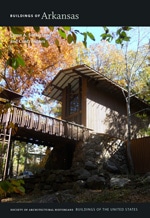Thompson and Harding’s Renaissance Revival-influenced city hall is three stories in height with a rusticated granite base and upper walls of beige brick. An imposing two-story projecting portico is carried on four stone Ionic columns, and the building has a dentiled cornice and a balustrade. Originally a tall dome covered the building, but by the 1950s the dome had deteriorated to the point of becoming a safety hazard, and it was removed in 1956, leaving only its square base. In 1983, proposals for demolition of the deteriorated city hall in favor of a new and larger structure were rejected and, instead, in recognition of the building’s historic and architectural significance, it was annexed to the fire station (1913, Charles L. Thompson) next door, which had been vacant since 1977. The fire station, also of beige brick with a facade of monumental Ionic columns that complements the city hall, is now joined to it by an inconspicuous setback hyphen, thereby preserving the facades of both buildings. Most of the fire station’s fixtures were removed for its conversion to office space for the city hall.
You are here
Little Rock City Hall
If SAH Archipedia has been useful to you, please consider supporting it.
SAH Archipedia tells the story of the United States through its buildings, landscapes, and cities. This freely available resource empowers the public with authoritative knowledge that deepens their understanding and appreciation of the built environment. But the Society of Architectural Historians, which created SAH Archipedia with University of Virginia Press, needs your support to maintain the high-caliber research, writing, photography, cartography, editing, design, and programming that make SAH Archipedia a trusted online resource available to all who value the history of place, heritage tourism, and learning.













